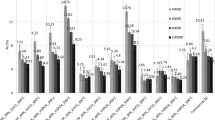Abstract
The objective of this study was to assess the uptake of hexavalent chromium from aqueous solutions by mosambi (Citrus limetta) peel dust. A batch adsorption procedure was used to test the suitability of the fruit peel dust as an adsorbent for hexavalent chromium (reduction-coupled adsorption). The effect of different conditions, for example contact time, sorbate concentration, solution pH, and temperature, on sorption were investigated, and maximum uptake of hexavalent chromium from contaminated water was 250 mg g−1 at pH 2.0 and 40 °C. Hexavalent chromium uptake from contaminated water followed a pseudo-first-order rate expression. ΔG 0, ΔH 0, and ΔS 0 were evaluated and it was concluded that sorption was feasible, spontaneous, and endothermic in nature. The process is in good agreement with the Langmuir isotherm. The nature of possible adsorbent–metal ion interactions was examined by use of FTIR spectroscopy. This revealed the involvement in chromium binding of –OH, –NH, C=O, and C–O groups on the cell surfaces. This study indicated that mosambi peel can be used as an effective and environmentally friendly biosorbent for treatment of hexavalent chromium-containing contaminated water.
Graphical Abstract
Hexavalent chromium compounds are more toxic than trivalent chromium because of their high water solubility and mobility. Mosambi (Citrus limetta) peel effectively removes hexavalent chromium from contaminated water by reducing it to trivalent chromium.











Similar content being viewed by others
Abbreviations
- C e :
-
Equilibrium concentration of solute in the bulk solution (mg L−1)
- C 0 :
-
Initial concentration of adsorbate in contact with the adsorbent (mg L−1)
- q :
-
Amount of metal ion adsorbed by the adsorbent (mg g−1)
- dq :
-
Differential of q
- q e :
-
Amount of the adsorbate adsorbed at equilibrium (mg g−1)
- Q max :
-
Maximum adsorption capacity of the adsorbent (mg g−1)
- b :
-
Langmuir’s constant
- C Ae :
-
Equilibrium concentration of solute on the adsorbent (mg L−1)
- K F :
-
The Freundlich constant related to adsorption capacity (mg g−1 (mg L−1)−1/n)
- n :
-
Dimensionless exponents of the Freundlich equation
- K c :
-
Equilibrium constant
- q t :
-
Amount of adsorbate adsorbed at time t (mg g−1)
- t :
-
Time of contact
- V :
-
Volume of adsorbate in contact with the adsorbent (L)
- R :
-
Universal gas constant
- ΔG 0 :
-
Change in standard free energy (kJ mol−1)
- ΔH 0 :
-
Change in standard enthalpy (kJ mol−1)
- ΔS 0 :
-
Change in standard entropy (J K−1 mol−1)
- T :
-
Absolute temperature (K)
References
B. Saha, C. Orvig, Coord. Chem. Rev. 254, 2959 (2010)
R. Saha, R. Nandi, B. Saha, J. Coord. Chem. 64, 1782 (2011)
C. Bourotte, R. Bertolo, M. Almodovar, R. Hirata, Annals Braz. Acad. Sci. 81, 227 (2009)
J. Mandal, K.M. Chowdhury, K.K. Paul, B. Saha, J. Coord. Chem. 63, 99 (2010)
A.K. Das, Coord. Chem. Rev. 248, 81 (2004)
M. Islam, B. Saha, A.K. Das, J. Mol. Catal. A Chem. 266, 21 (2007)
R. Saha, A. Ghosh, B. Saha, J. Coord. Chem. 64, 3729 (2011)
K.M. Chowdhury, J. Mandal, B. Saha, J. Coord. Chem. 2009, 62 (1871)
D.E. Kimbrough, Y. Cohen, A.M. Winer, L. Creelman, C.A. Mabuni, Crit. Rev. Environ. Sci. Technol. 29, 1 (1999)
D. Park, Y.S. Yun, J.Y. Kim, J.M. Park, Chem. Eng. J. 136, 173 (2008)
S. Rengaraj, K.H. Yon, S.H. Moon, J. Hazard. Mater. 87, 273 (2001)
D. Petruzzelli, R. Passino, G. Tiravanti, Ind. Eng. Chem. Res. 34, 2612 (1995)
C.A. Kozlowski, W. Walkosiak, Water Res. 36, 4870 (2002)
F. Akbal, S. Camci, Chem. Eng. Technol. 33, 1655 (2010)
E. Salazar, M.I. Ortiz, A.M. Urtiaga, Ind. Eng. Chem. Res. 31, 1516 (1992)
H. Ozaki, K. Sharma, W. Saktaywin, Desalination 144, 287 (2002)
T. Mohammadi, A. Moheb, M. Sadrzadeh, A. Razmi, Sep. Purif. Technol. 41, 73 (2005)
S. Babel, T.A. Kurniawan, J. Hazard. Mater. B97, 219 (2003)
M.X. Loukidou, T.D. Karapantsios, A.I. Zouboulis, K.A. Malis, Ind. Eng. Chem. Res. 43, 1748 (2004)
K. Parvathia, R. Nagendrana, Sep. Sci. Technol. 42, 625 (2007)
L.K. Cabatingan, R.C. Agapay, J.L.L. Rakels, M. Ottens, L.A.M. Vaner Wielen, Ind. Eng. Chem. Res. 40, 2302 (2001)
M. Kobya, Bioresour. Technol. 91, 317 (2004)
P. Suksabye, P. Thiravetyan, W. Nakbanpote, S. Chayabutra, J. Hazard. Mater. 141, 637 (2007)
A. Verma, S. Chakraborty, J.K. Basu, Sep. Purif. Technol. 50, 336 (2006)
V. Sarin, K.K. Pant, Bioresour. Technol. 97, 15 (2006)
Y. Khambhaty, K. Mody, S. Basha, B. Jha, Chem. Eng. J. 145, 489 (2009)
G. Limousin, J.P. Gaudet, L. Charlet, S. Szenknect, V. Barthes, M. Krimissa, Appl. Geochem. 22, 249 (2007)
D. Mohan, K.P. Singh, V.K. Singh, Ind. Eng. Chem. Res. 1027, 44 (2005)
K.K. Singh, R. Rastogi, S.H. Hasan, J. Colloid Interface Sci. 290, 61 (2005)
K. Srividya, K. Mohanty, Chem. Eng. J. 155, 666 (2009)
Acknowledgments
The authors are thankful to the CSIR, New Delhi, India, for financial support in the form of a project and a fellowship.
Author information
Authors and Affiliations
Corresponding authors
Rights and permissions
About this article
Cite this article
Saha, R., Mukherjee, K., Saha, I. et al. Removal of hexavalent chromium from water by adsorption on mosambi (Citrus limetta) peel. Res Chem Intermed 39, 2245–2257 (2013). https://doi.org/10.1007/s11164-012-0754-z
Received:
Accepted:
Published:
Issue Date:
DOI: https://doi.org/10.1007/s11164-012-0754-z




